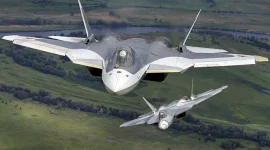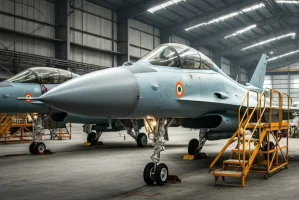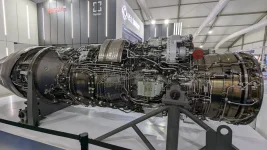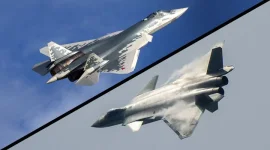A recent report by the U.S. Department of Defense has highlighted the rapid and extensive military modernization underway in China, raising concerns about the shifting balance of power in the Indo-Pacific region and posing a significant challenge to India's national security.
The report, coupled with recent developments like speculation surrounding a new Chinese combat aircraft and China's ambitious dam project on the Brahmaputra River, underscores the urgent need for India to accelerate its own military modernization efforts on a "mission mode" basis.
The Pentagon's annual report, titled "Military & Security Developments Involving the People's Republic of China 2024," submitted to the U.S. Congress, outlines China's strategic goal of achieving "the great rejuvenation of the Chinese nation" by 2049. This ambition is being pursued through a comprehensive strategy encompassing political, social, economic, technological, and military development, all aimed at strengthening China's national power and reshaping the international order in its favor. The report suggests China is rapidly advancing its military capabilities across all domains, from its navy and air force to its missile forces and cyber warfare capabilities.
The People's Liberation Army (PLA) is undergoing a sweeping modernization process, with significant investments pouring into advanced weaponry and technology. The report details the PLA Navy's (PLAN) growth into the world's largest navy numerically, now boasting over 370 ships and submarines, including more than 140 major surface combatants.
The PLAN has transitioned from a focus on "offshore defense" to "open seas protection," demonstrating its intent to project power far beyond China's immediate shores. This is exemplified by extended deployments of its Yushen-class amphibious assault ship and the aircraft carrier Shandong, both operating outside the First Island Chain.
The next generation Fujian-class carriers are also being worked on, with enhanced endurance, faster launch capability, and greater strike potential. According to the U.S. Naval Institute, the first of these carriers, the Fujian (CV-18), was launched in June 2022 and is expected to be commissioned in 2024 or 2025.
Similarly, the PLA Air Force (PLAAF) is rapidly modernizing and indigenizing its aircraft and unmanned aerial systems (UAS), shifting from a defensive posture to a more offensive one with long-range strike capabilities. Development of the H-20 long-range bomber, with an expected range exceeding 10,000 km, is reportedly underway. This, coupled with the Y-20U flight refueling aircraft, significantly enhances the PLAAF's ability to conduct long-range offensive air operations. The PLAAF's ambition to become a "strategic" air force is central to China's broader goal of achieving superpower status.
The PLA Rocket Force (PLARF) is also undergoing significant modernization, developing sophisticated conventional missile capabilities to enhance its "strategic deterrence." The report notes the operational deployment of the DF-17, a hypersonic glide vehicle (HGV) capable medium-range ballistic missile (MRBM), and suggests that China might be exploring the development of conventionally armed intercontinental-range missile systems capable of striking the continental U.S., Hawaii, and Alaska. The Stockholm International Peace Research Institute (SIPRI) estimates that China's nuclear arsenal has grown from 410 warheads in January 2023 to 500 in January 2024 and is expected to continue growing.
Beyond its military advancements, the Pentagon report highlights China's growing global military presence, expanding through counter-piracy missions, overseas base construction, and increased military cooperation with other nations. Its military attaché presence has expanded to over 110 locations worldwide, further reflecting its growing involvement in promoting its foreign policy objectives.
This includes increased activities in the Arctic and Antarctic regions. Qingling Station, China's fifth research station in Antarctica, is strategically positioned to gather signals intelligence over Australia and New Zealand, providing the PLA with enhanced surveillance capabilities. This is especially concerning for the Quad countries—India, the U.S., Japan, and Australia—which share a common interest in maintaining a free and open Indo-Pacific, a vision increasingly challenged by the PLA's growing assertiveness.
Meanwhile, recent speculation about a new Chinese combat aircraft, potentially a sixth-generation fighter or stealth bomber, and China's decision to proceed with a massive dam on the Brahmaputra River have further heightened concerns in India. While China has attempted to reassure India and Bangladesh about the dam's impact, its response has been met with skepticism given the potential for significant downstream effects on water flow and ecosystems. This project is estimated to cost US $137 billion.
India faces a "momentous challenge" to its security as it confronts a rapidly modernizing and increasingly assertive China. The widening military gap between the two nations necessitates a concerted and urgent response from India. The report from the Pentagon concludes that the PLA is continuously developing capabilities to dissuade, deter, and potentially defeat third-party interference in the Indo-Pacific. The report also indicates increased use of technologies like AI, quantum computing, and big data to enhance military operations.
Experts stress that recent disengagement in Ladakh should not be interpreted as a sign of reduced threat, but rather a temporary tactical maneuver. The current situation marks the first time in India's history that it faces a neighbor rapidly ascending to superpower status, a development that demands a fundamental reassessment of India's defense preparedness.
While India's defense personnel are highly regarded, they require top-tier military hardware and resources to effectively counter the growing capabilities of the PLA. Critics argue that India's defense establishment has been slow to adapt, with bureaucratic hurdles and a lack of strategic focus hindering modernization efforts. There is a stark contrast between China's "frenzied" military modernization and India's approach, which some perceive as being distracted by non-essential activities.
Therefore, to bridge this gap, India must adopt a "mission mode" approach to defense capability development in 2025, prioritizing the acquisition of advanced weaponry, enhancing indigenous defense production, and streamlining procurement processes to ensure its armed forces are equipped to meet the evolving security challenges posed by a rising China.




